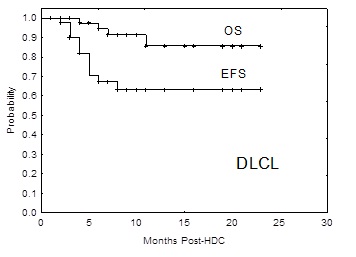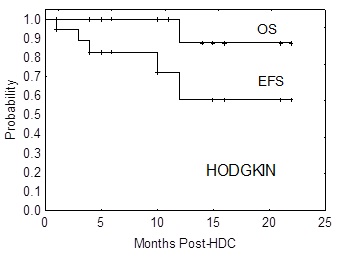Abstract
More active high-dose regimens are needed for non-Hodgkin’s (NHL) and Hodgkin’s lymphomas (HL), where standard BEAM offers poor results in refractory or poor-risk relapsed tumors. We previously developed a regimen of infusional gemcitabine with busulfan and melphalan (Gem/Bu/Mel), exploiting the synergy between gemcitabine and alkylators based on inhibition of DNA damage repair. Gem/Bu/Mel was safe and highly active against refractory lymphomas (Nieto, BBMT 2012). To further increase its activity we combined it in preclinical experiments with SAHA, which induces relaxation of the chromatin and renders DNA more accessible to DNA-targeting agents. Concurrent exposure to SAHA and Gem/Bu/Mel resulted in markedly increased apoptosis and cytotoxicity in refractory B- and T-NHL lines, with increased PARP1 cleavage and γ-H2AX reflecting increased DNA damage (Valdez, Exp Hematol 2012). SAHA has a dose-response effect in refractory lymphoma lines up to clinically achievable levels with doses of 1,000 mg, higher than its usual dose. We wished to clinically study the concurrent combination of SAHA and Gem/Bu/Mel in refractory NHL and HL.
Patients ages 12-65 with refractory lymphomas and adequate end-organ function were eligible for this dose-finding study of SAHA combined with Gem/Bu/Mel. SAHA was given on days -8 to -3 at 200-1,000 mg PO daily (levels 1-11), preceding all chemotherapy. Gemcitabine was given as a loading dose of 75 mg/m2 followed by infusion at a fixed dose rate of 10 mg/m2/min over 3.5 (levels 1-5), 4 (level 6) or 4.5 hours (levels 7-11) on days -8 and -3. Each gemcitabine dose was immediately followed by the corresponding dose of busulfan or melphalan. After a test dose on day -10, busulfan was given from days-8 to -5 targeting a daily AUC of 4,000. Melphalan was infused at 60 mg/m2/day on days -3 and -2. ASCT was on day 0. Patients with CD20+ tumors received rituximab (375 mg/m2) on days +1 and +8. Dose limiting toxicities (DLT) were defined as any G4-5 nonhematological organ toxicity, or as G3 skin or G3 mucositis lasting >3 days at peak severity. Dose escalation followed a Bayesian design targeting a maximal DLT probability of 20%.
Between 10/11 and 6/13, 66 patients were enrolled with DLCL, HL and T-NHL (Table 1).
SAHA was escalated up to 1,000 mg PO daily, combined with full doses of Gem/Bu/Mel without encountering DLTs. There were no treatment-related deaths. The toxicity profile was manageable, including mucositis (48% G2, 31% G3), skin (11% G2, 3% G3), self-limited transaminase elevation (30% G2, 6% G3), and self-limited elevation of bilirubin not associated to VOD (22% G2, 16% G3). There were no cardiac, pulmonary, renal or CNS toxicities. There was no QT prolongation detected after SAHA. Neutrophils and platelets engrafted promptly at median days +10 (range, 8-13) and +12 (range, 8-55), respectively. This toxicity profile is undistinguishable from the one we previously described with Gem/Bu/Mel.
Activity and patient outcomes at median follow-up of 8 months (1-23) are shown on Table 2 and Figures:
Patient population.
| . | DLCL . | HL . | T-NHL . |
|---|---|---|---|
| N | 47 | 16 | 3 |
| Median age (range) | 52 (23-66) | 37 (18-61) | 54 (41-58) |
| Primary induction failure / high-risk or refractory relapse | 27 / 20 | 9 / 7 | 2 / 1 |
| Major subtypes | 9 double hit | 2 AITL 1 Hepatosplenic | |
| Median # prior chemotherapy lines (range) | 3 (2-5) | 3 (3-7) | 2 (2-3) |
| Prior xRT | 15 | 6 | 0 |
| PET+ at HDC | 25 (53%) | 8 (50%) | 1 (33%) |
| Status at HDC: CR / PR / No response | 22 / 11 / 14 | 8 /4 / 4 | 2 / 0 / 1 |
| PD at HDC | 9 (19%) | 4 (25%) | 1 (33%) |
| . | DLCL . | HL . | T-NHL . |
|---|---|---|---|
| N | 47 | 16 | 3 |
| Median age (range) | 52 (23-66) | 37 (18-61) | 54 (41-58) |
| Primary induction failure / high-risk or refractory relapse | 27 / 20 | 9 / 7 | 2 / 1 |
| Major subtypes | 9 double hit | 2 AITL 1 Hepatosplenic | |
| Median # prior chemotherapy lines (range) | 3 (2-5) | 3 (3-7) | 2 (2-3) |
| Prior xRT | 15 | 6 | 0 |
| PET+ at HDC | 25 (53%) | 8 (50%) | 1 (33%) |
| Status at HDC: CR / PR / No response | 22 / 11 / 14 | 8 /4 / 4 | 2 / 0 / 1 |
| PD at HDC | 9 (19%) | 4 (25%) | 1 (33%) |
Activity/outcomes.
| . | RR . | CR . | 1-year EFS . | 1-year OS . |
|---|---|---|---|---|
| HL | 88% | 88% | 72% | 94% |
| B-DLCL | 96% | 72% | 71% | 91% |
| T-NHL | 100% | 100% | 100% | 100% |
| . | RR . | CR . | 1-year EFS . | 1-year OS . |
|---|---|---|---|---|
| HL | 88% | 88% | 72% | 94% |
| B-DLCL | 96% | 72% | 71% | 91% |
| T-NHL | 100% | 100% | 100% | 100% |
Concurrent administration of SAHA with high-dose GemBuMel is feasible up to a daily dose of SAHA of 1,000 mg, with no increased toxicities compared to Gem/Bu/Mel alone. Early results indicate that SAHA/Gem/Bu/Mel is highly active in refractory or poor-risk relapsed HL and DLCL and warrants further study in earlier disease stages. Longer follow-up is needed to confirm these findings.
Nieto:Otsuka Pharmaceuticals: Research Funding. Off Label Use: Vorinostat not approved for DLCL or Hodgkin's lymphoma. Qazilbash:Otsuka Pharmaceuticals: Research Funding. Andersson:Otsuka Pharmaceuticals: Research Funding.
Author notes
Asterisk with author names denotes non-ASH members.



This feature is available to Subscribers Only
Sign In or Create an Account Close Modal